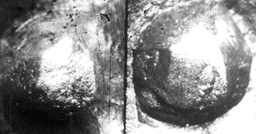In a murder case, four 12 bore cartridges were fired from a 12 bore SBBL gun. After committing the crime, the accused broke his 12 bore licensed gun. The investigating officer recovered all the broken parts of the gun from the possession of the accused.The broken gun parts and the four fired cartridges(recovered from the crime scene) were sent to the laboratory for examination and comparison. On examination it was found that almost all the parts of the SBBL gun were hammered and broken.( FIG 1).

FIG1

FIG2
On examining the fired cartridges it was observed that the firing pin marks on all the four cartridges were similar. As the gun was broken and unserviceable it was necessary to obtain firing pin marks by adopting a suitable procedure that obviated the necessity of firing. A suitable metal surface softer than metal of the primer was chosen for the purpose. Thin soft lead piece (or flattened buckshot) was placed on the firing pin and pressed by applying sufficient force. The firing pin marks obtained on test lead specimens tallied with the firing pin marks present on the crime cartridges thereby establishing the linkage of the crime with the licensed broken gun of the accused.(FIG 3)

FIG 3
Firing pin marks matching
